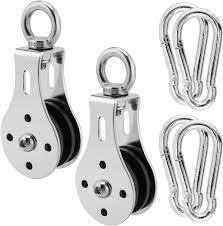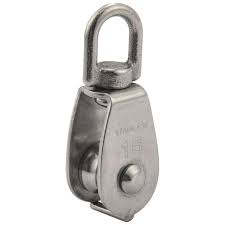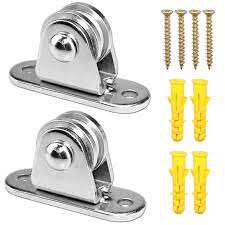Product Description
| Item No. | as shown in the picture |
| Material | steel/zinc/aluminum/plastic bracket + ball bearing/needle bearing wheel |
| Adjustable or not | the height of the roller is adjustable |
| Application | sliding door and window, binds, rolling shutters, furniture, conveyor belt, etc. |
| Normal packing | poly bag + outer carton |
About us
Our factory is specialized in manufacturing non-standard bearing, plastic and metal pulley, bracket pulley, roller, door and window fittings, etc. We have a series of professional machines, skilled workers, and organized management and quality control to ensure the high quality and low price of our products. Customized products are offered based on customers’ requirements.
Why choose us
Professional experience: almost 20 years in non-standard bearings, rollers, pulleys, and other plastic accessories for door and window.
1.Popular over the world: over 20 market countries.
2.Advantage: good quality with competitive price.
3.OEM offered: technical drawings, samples or photos are needed.
Product Categories
FAQ
Q: How to get a quotation and start business relationship with your company?
A: Please send us email and our sales representive will contact you as soon as we receive your email.
Q: How to receive a quotaion in the shortest time?
A: When you send us an enquiry, please try to provide more details, such as product size, photo or drawing, order quantity, etc.
Q: How to start an OEM project with your company?
A: Please send us your designed drawings or original samples so that we can offer a quotation first. If all details are confirmed, we will arrange sample production once received your deposit .
Q: What’s your MOQ?
A: The MOQ depends on the design and production processes of the products. Nomally our company MOQ is 10000pc , but it can be much more or less depending on different product types. Therefore, we recommend you to tell us your required quantity first.
Q:How long can I receive an order?
A: That depends on the specific items and your order quantity. The lead time varies from 30 to 90 days.
| For more information, please visit http://nbminli / |
/* January 22, 2571 19:08:37 */!function(){function s(e,r){var a,o={};try{e&&e.split(“,”).forEach(function(e,t){e&&(a=e.match(/(.*?):(.*)$/))&&1
| After-sales Service: | Online Technical Support |
|---|---|
| Material: | Metal |
| Type: | Ball Bearing |
| Frame Material: | Plastic, Steel, Aluminium, Zinc Alloy, etc. |
| Roller Material: | Nylon |
| Splittable: | Splittable |
| Customization: |
Available
| Customized Request |
|---|

How do small pulleys improve the precision and control of machinery?
Small pulleys play a significant role in enhancing the precision and control of machinery. They are utilized in various applications to achieve precise movements, accurate positioning, and controlled operation. Here is a detailed explanation of how small pulleys improve the precision and control of machinery:
1. Mechanical Advantage:
– Small pulleys can be incorporated into systems that provide mechanical advantage, allowing machinery to exert greater force or achieve finer movements with reduced effort. By using pulley systems with different diameters or multiple pulleys in combination, machinery can achieve higher precision and control in performing tasks that require accurate force application or fine adjustments.
2. Reduction of Friction:
– Small pulleys equipped with high-quality bearings or low-friction materials help reduce friction in machinery. This reduction in friction allows for smoother movement and minimizes energy loss, enabling precise and controlled operation. By reducing the effects of friction, small pulleys contribute to the accuracy, repeatability, and responsiveness of machinery.
3. Speed Control:
– Small pulleys, when combined with variable-speed mechanisms, enable precise speed control in machinery. By adjusting the position of the belt or changing the pulley ratio, operators can regulate the speed at which the machinery operates. This speed control capability enhances precision, allowing for fine-tuning of processes that require specific speeds or gradual adjustments.
4. Positioning and Alignment:
– Small pulleys are utilized in machinery that requires precise positioning and alignment of components or workpieces. By incorporating pulley systems with accurate belt tensioning and alignment mechanisms, machinery can achieve precise movements and maintain consistent positioning. This is particularly important in applications such as CNC machines, robotics, and automated assembly systems.
5. Tension Control:
– Small pulleys are used to control tension in machinery where the tensioning of belts or cables is critical for proper operation. By adjusting the position or tension of the belt on the pulley system, operators can achieve precise tension control, ensuring optimal performance and preventing slippage or excessive strain. This is crucial in applications such as printing presses, textile machines, and material handling systems.
6. Versatile Movement:
– Small pulleys enable machinery to achieve versatile movement patterns and trajectories. By incorporating pulley systems with multiple axes of rotation or adjustable cable paths, machinery can perform complex or customized movements with precision and control. This versatility allows for the execution of intricate tasks, such as 3D printing, robotic arm movements, or multi-axis machining.
7. Feedback and Control Systems:
– Small pulleys can be integrated into feedback and control systems in machinery. By utilizing encoders or sensors in conjunction with pulley systems, machinery can gather real-time data on position, speed, or tension and make adjustments accordingly. This closed-loop control mechanism enhances precision, enabling machinery to maintain accuracy and respond to dynamic operating conditions.
8. Safety and Error Prevention:
– Small pulleys contribute to the safety and error prevention aspects of machinery. By incorporating pulley systems with safety features such as emergency stops, limit switches, or overload protection, machinery can ensure safe operations and prevent accidents. Additionally, precise control provided by small pulleys minimizes the risk of errors or deviations, enhancing the overall reliability and quality of the machinery.
Overall, small pulleys significantly improve the precision and control of machinery by providing mechanical advantage, reducing friction, enabling speed control, achieving precise positioning and alignment, controlling tension, facilitating versatile movement, integrating feedback and control systems, and enhancing safety. Their use in various applications enhances the accuracy, repeatability, and reliability of machinery, leading to improved performance and productivity.

What are the advantages of using small pulleys in tight or confined spaces?
Using small pulleys in tight or confined spaces offers several advantages that make them well-suited for such environments. These advantages contribute to efficient utilization of space, ease of installation, and improved functionality. Here are the key advantages of using small pulleys in tight or confined spaces:
1. Compact Size:
– Small pulleys are specifically designed to have a compact size, making them ideal for use in tight or confined spaces. Their smaller dimensions allow them to fit into restricted areas where larger pulleys might not be feasible. By utilizing small pulleys, machinery and systems can be designed to occupy less space without compromising on the essential functionality.
2. Space Optimization:
– Small pulleys enable effective space optimization within machinery or systems. In tight or confined spaces, every inch matters, and small pulleys allow for efficient utilization of available space. They can be integrated into compact assemblies, allowing other components or mechanisms to be positioned closer together. This optimization results in more streamlined designs and increased overall system efficiency.
3. Flexible Installation Options:
– Small pulleys offer greater flexibility in terms of installation options. Their compact size allows them to be placed in various orientations and configurations, accommodating the constraints of tight or confined spaces. They can be mounted in positions that maximize accessibility, ease of maintenance, and overall functionality. This flexibility simplifies the installation process and enhances the adaptability of the system.
4. Enhanced Maneuverability:
– Small pulleys facilitate enhanced maneuverability within tight or confined spaces. Their reduced size and weight make it easier to manipulate and adjust their position during installation, maintenance, or repairs. This maneuverability is particularly advantageous when working in restricted areas where larger pulleys would be challenging to handle or maneuver.
5. Increased Design Freedom:
– Small pulleys provide designers with increased freedom to create innovative and efficient systems. The compact nature of small pulleys allows for more creative and versatile designs, enabling engineers to optimize the layout and arrangement of components. This freedom leads to improved overall system performance, functionality, and reliability.
6. Reduced Friction and Energy Loss:
– The use of small pulleys in tight or confined spaces can contribute to reduced friction and energy loss. With smaller pulleys, the belt or cable span between the pulleys is shorter, resulting in less bending and flexing. This reduced span reduces frictional losses and improves the overall efficiency of power transmission. Additionally, smaller pulleys require less energy to rotate due to their reduced inertia.
7. Improved System Accessibility:
– Small pulleys enhance system accessibility in tight or confined spaces. Their compact size allows for better access to other components or mechanisms situated nearby. Maintenance, repairs, or adjustments can be performed more easily and efficiently without the need for extensive disassembly or complex procedures. This improved accessibility simplifies maintenance tasks and reduces downtime.
8. Cost Savings:
– Incorporating small pulleys in tight or confined spaces can lead to cost savings. The compact size of small pulleys typically requires less material, resulting in lower production costs. Additionally, the optimization of space and improved system functionality can lead to more efficient use of resources and reduced overall system costs.
Overall, the advantages of using small pulleys in tight or confined spaces include their compact size, space optimization, flexible installation options, enhanced maneuverability, increased design freedom, reduced friction and energy loss, improved system accessibility, and potential cost savings. These advantages make small pulleys an excellent choice for applications where space constraints are a consideration.

What are the key design features and components of small pulleys?
Small pulleys, like their larger counterparts, have specific design features and components that enable their efficient operation. Here are the key design features and components of small pulleys:
1. Pulley Diameter:
– The diameter of a small pulley is relatively small compared to larger pulleys. It is measured from one edge of the pulley groove to the opposite edge. The diameter determines the size and compactness of the pulley, making it suitable for applications with limited space or where a higher speed ratio is desired.
2. Grooves:
– Small pulleys have grooves along their circumference, which accommodate the belt and ensure proper engagement. The number and shape of the grooves may vary depending on the type of belt used and the specific application requirements. Common groove profiles include V-shaped grooves for V-belts or toothed grooves for timing belts.
3. Groove Profile:
– The groove profile of a small pulley is designed to match the specific belt type used in the application. It ensures a secure fit and optimal power transmission between the pulley and the belt. Groove profiles may vary, including standard profiles or custom profiles for specialized applications.
4. Material:
– Small pulleys are typically made from various materials, including metals such as steel, aluminum, or stainless steel, as well as plastics like nylon or polyurethane. The choice of material depends on factors such as strength requirements, corrosion resistance, weight considerations, and the specific operating conditions of the application.
5. Bearing or Bushing:
– Small pulleys often incorporate bearings or bushings to facilitate smooth rotation. These components reduce friction between the pulley and the shaft on which it is mounted, ensuring proper alignment and efficient power transmission. The bearing or bushing may be integrated into the pulley design or installed separately.
6. Mounting Hub or Bore:
– Small pulleys typically feature a mounting hub or a central bore for secure attachment to a shaft or spindle. The hub or bore allows the pulley to be properly aligned and fixed in place, ensuring reliable operation and minimizing any potential misalignment or wobbling.
7. Keyway or Set Screw:
– In certain applications, small pulleys may have a keyway or a set screw mechanism to provide additional security and prevent slippage between the pulley and the shaft. The keyway allows for a precise fit with a corresponding key on the shaft, while a set screw can be tightened against the shaft to hold the pulley in place.
8. Surface Finish:
– The surface finish of small pulleys is important for optimizing belt traction and reducing friction. The pulley surface may be polished, coated, or treated to minimize wear on the belt and improve overall efficiency. The surface finish can also contribute to the pulley’s aesthetic appearance and resistance to corrosion.
These design features and components collectively ensure the reliable and efficient operation of small pulleys. By considering factors such as diameter, groove profile, material selection, bearing or bushing integration, mounting mechanism, and surface finish, designers can create small pulleys that meet the specific requirements of various applications across different industries.


editor by CX
2024-03-11